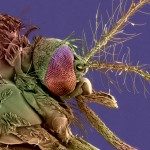Link to Pubmed [PMID] – 24672026
Link to HAL – pasteur-01464435
Link to DOI – 10.1128/JVI.00370-14
Journal of Virology, 2014, 88 (11), pp.6294-306. ⟨10.1128/JVI.00370-14⟩
Chikungunya virus (CHIKV) causes a major public health problem. In 2004, CHIKV began an unprecedented global expansion and has been responsible for epidemics in Africa, Asia, islands in the Indian Ocean region, and surprisingly, in temperate regions, such as Europe. Intriguingly, no local transmission of chikungunya virus (CHIKV) had been reported in the Americas until recently, despite the presence of vectors and annually reported imported cases. Here, we assessed the vector competence of 35 American Aedes aegypti and Aedes albopictus mosquito populations for three CHIKV genotypes. We also compared the number of viral particles of different CHIKV strains in mosquito saliva at two different times postinfection. Primarily, viral dissemination rates were high for all mosquito populations irrespective of the tested CHIKV isolate. In contrast, differences in transmission efficiency (TE) were underlined in populations of both species through the Americas, suggesting the role of salivary glands in selecting CHIKV for highly efficient transmission. Nonetheless, both mosquito species were capable of transmitting all three CHIKV genotypes, and TE reached alarming rates as high as 83.3% and 96.7% in A. aegypti and A. albopictus populations, respectively. A. albopictus better transmitted the epidemic mutant strain CHIKV_0621 of the East-Central-South African (ECSA) genotype than did A. aegypti, whereas the latter species was more capable of transmitting the original ECSA CHIKV_115 strain and also the Asian genotype CHIKV_NC. Therefore, a high risk of establishment and spread of CHIKV throughout the tropical, subtropical, and even temperate regions of the Americas is more real than ever. IMPORTANCE : Until recently, the Americas had never reported chikungunya (CHIK) autochthonous transmission despite its global expansion beginning in 2004. Large regions of the continent are highly infested with Aedes aegypti and Aedes albopictus mosquitoes, and millions of dengue (DEN) cases are annually recorded. Indeed, DEN virus and CHIK virus (CHIKV) share the same vectors. Due to a recent CHIK outbreak affecting Caribbean islands, the need for a Pan-American evaluation of vector competence was compelling as a key parameter in assessing the epidemic risk. We demonstrated for the first time that A. aegypti and A. albopictus populations throughout the continent are highly competent to transmit CHIK irrespective of the viral genotypes tested. The risk of CHIK spreading throughout the tropical, subtropical, and even temperate regions of the Americas is more than ever a reality. In light of our results, local authorities should immediately pursue and reinforce epidemiological and entomological surveillance to avoid a severe epidemic.

